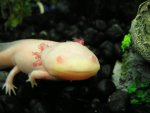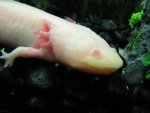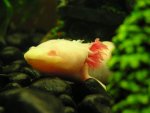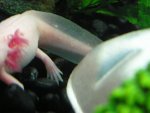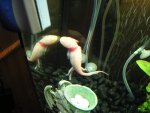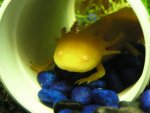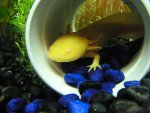Gothica Lily
New member
- Joined
- May 9, 2009
- Messages
- 62
- Reaction score
- 4
- Points
- 0
- Location
- Melbourne
- Country
- Australia
- Display Name
- Angie
Hi everyone,
Need some advice: both of our axies' skin seems to be peeling... Both are albinos. Because we have somne live plants which need light, we have normal white lamps there (we have them on for about 5 hours a day).
I noticed our white albino girl has been peeling the worst, and the golden albino which has sone leucistic color to it, nowhere near as much, but a tiny bit was coming off. I was worried it was fungus, and examined their gills which seem intact: pink to the tips, fluffy and all...
Diet is Night Crawlers. Gill growth and body mass doing well. Regenerative processes work well (bruises heal, damaged limbs growing).
Should I be running to the shops to buy a blacklight? Oh, and what is the norm on Nitrate levels with these axolotls? When should we be concerned?
Thanks,
Angie
Need some advice: both of our axies' skin seems to be peeling... Both are albinos. Because we have somne live plants which need light, we have normal white lamps there (we have them on for about 5 hours a day).
I noticed our white albino girl has been peeling the worst, and the golden albino which has sone leucistic color to it, nowhere near as much, but a tiny bit was coming off. I was worried it was fungus, and examined their gills which seem intact: pink to the tips, fluffy and all...
Diet is Night Crawlers. Gill growth and body mass doing well. Regenerative processes work well (bruises heal, damaged limbs growing).
Should I be running to the shops to buy a blacklight? Oh, and what is the norm on Nitrate levels with these axolotls? When should we be concerned?
Thanks,
Angie

